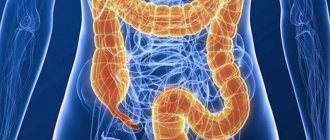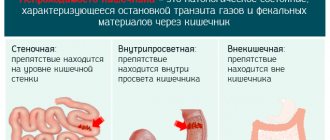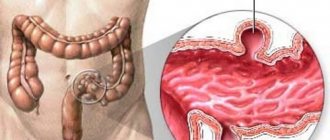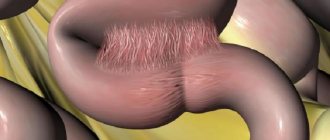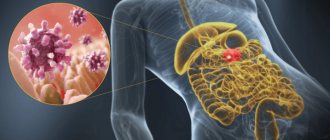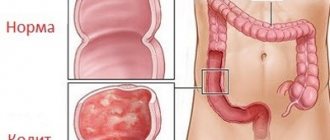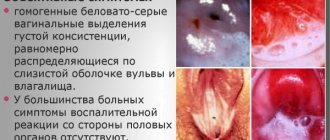Catarrhal colitis of the intestine is an acute inflammatory disease, which is most often caused by infectious causes. Common symptoms of colitis are abdominal pain and diarrhea. Treatment methods depend on the causative agent of the disease and accompanying symptoms. With timely treatment, complete cure is possible.
Causes
Catarrhal colitis of the intestine can occur for the following reasons:
- when infections such as staphylococci, streptococci, salmonella, etc. enter the body along with poor-quality water or food;
- due to diseases caused by parasitic worms;
- as a result of taking antibiotics and other medications that irritate the intestinal mucosa;
- due to external and internal toxins;
- with frequent stress;
- as a result of weakened immunity;
- due to dyspepsia;
- with poor nutrition.
Catarrhal colitis is quite often a symptom of an underlying disease. It develops due to intestinal diseases, dysbiosis, problems with stool: diarrhea, constipation. Its outbreaks occur mainly in the summer, when a person begins to include in his diet a large amount of berries and vegetables rich in fiber and sugar. Such food promotes the development of fermentation and putrefactive processes, leading first to dyspepsia, and subsequently to catarrhal colitis.
Classification and reasons for development
There is a division of catarrhal or superficial colitis depending on the location of the pathological process:
- a total inflammatory process that affects the entire surface of the large intestine. Found in every fifth patient with a similar diagnosis;
- left-sided intestinal inflammation - diagnosed in 25% of cases;
- manifestation of rectosigmoiditis – occurs in 55%.
Classification of catarrhal colitis
There are several known forms of this disease:
- acute – characterized by a sudden onset of symptoms and lasts no more than four days. If adequate treatment is not carried out during this time, inflammation will spread to the deeper layers of the colon;
- chronic – develops under conditions of complete absence or inadequate drug therapy.
In turn, chronic catarrhal colitis has its own classification and is divided into several forms:
- atonic or hypotonic – there is a periodic increase in the tone of certain areas of the affected organ, which is expressed in pain;
- distal or descending - characterized by the presence of hypertonicity in the sigmoid region and descending sections of this organ, while the lumen of the proximal sections remains normal;
- hypertonic – characterized by persistent hypertonicity of all parts of the large intestine, causing its lumen to narrow unevenly. The main clinical manifestation of this form is the slow movement of feces, as well as the presence of purulent mucus in the excrement.
Catarrhal colitis is classified into spastic, distal and hypertensive colitis. With spastic colitis, there is a strong tone of the intestinal walls, which provokes spasms.
With this type of disease, difficult passage of stool is observed, in which a large amount of mucus is detected. There are several factors that provoke the development of catarrhal colitis of the colon:
- intestinal infections, dysbacteriosis;
- lack of vitamins in the body;
- weakened immune system;
- consuming large amounts of fiber and sugar;
- invasion, parasitic dyspepsia;
- the presence of infection in the digestive organs;
- effects of endogenous toxins on the intestines;
- long-term use of antibiotics and other medications;
- neurotic conditions, stress, frequent depression.
During the development of the disease, a person experiences characteristic symptoms. Unpleasant pain appears in the abdominal area, there are spasmodic pains, flatulence and frequent belching.
A sick person may complain of fatigue, drowsiness, headache and general weakness. In addition, problems with bowel movements are provoked; stool disorder is often observed, which can alternate with painful constipation.
Blood clots or mucus may be visible in the stool. With catarrhal colitis, an increase in body temperature is also possible. If you ignore the first signs, the disease will develop into chronic colitis, seriously affecting sections of the large intestine.
Symptoms
The ongoing inflammatory process often leads to the intestinal walls beginning to redden and swell. Its lumen narrows slightly. Because of this, cracks of varying sizes often occur. Inflammation can affect both individual areas of the colon and its entire surface. If it is localized quite clearly, a diagnosis of “focal catarrhal colitis” is made. The illness lasts only three days. Treatment in this case should be started immediately so that the disease does not become chronic.
Thus, if catarrhal colitis occurs, its symptoms may be as follows:
- There is cramping pain in the lower abdomen.
- There is loss of appetite, malaise, weakness, and increased fatigue.
- I am concerned about indigestion, frequent diarrhea and constipation.
- There is a bitterness in the mouth, bad breath, and belching.
- The patient complains of bloating and increased gas formation.
- Insomnia and irritability are observed.
Symptoms
The most characteristic signs of catarrhal colitis of the intestine are the course of the inflammatory process, the appearance of foci of necrosis and bleeding in the mucous membrane of this organ. However, such changes can only be detected during laboratory and instrumental diagnostics. External manifestations of the disease include:
- pain and discomfort in the abdomen;
- increased accumulation of gases;
- bloating, which is expressed in an increase in the size of the abdomen;
- constant disturbance of stool, which is expressed in alternation of constipation and diarrhea or in the predominance of one of the symptoms;
- the appearance of impurities of pus and blood in the stool;
- weakness and causeless irritability;
- decreased or complete lack of appetite;
- burping;
- false urge to defecate;
- headache;
- the appearance of a bitter taste in the mouth;
- pronounced bad breath;
- increase in body temperature.
It is worth noting that after four days all the above symptoms will disappear on their own. Patients perceive this as recovery, but in fact it indicates that the disease has become chronic.
The chronic inflammatory process, in the vast majority of cases, is asymptomatic; an exacerbation may be indicated by the appearance of impurities in the stool.
The occurrence of chronic catarrhal colitis
If the disease is not treated in time, it often becomes chronic. It can be completely asymptomatic until small amounts of mucus appear in the stool. Chronic catarrhal colitis is divided into several types, each of which has its own characteristic symptoms:
- distal (descending) – causes increased tone of the sigmoid and descending sections;
- spastic – promotes spasms and increased tone of the intestinal walls;
- hypotonic - leads to hypertonicity of the entire colon, a narrow uneven lumen and spastic areas are observed.
The third type occurs most often in people who have relatively recently suffered from intestinal infections or dysbacteriosis. The risk group may include those who abuse flour and sweet products, and also experience a lack of vitamins and minerals.
Prevention of colitis
The main preventive measures to prevent the occurrence of catarrhal and other forms of colitis are:
- healthy, active lifestyle;
- a rational nutrition system, including healthy, properly processed and prepared meals and products;
- exclusion from the fast food menu;
- normal drinking regime;
- compliance with basic hygiene rules at home;
- absence or timely disposal of bad habits, including constant overeating;
- dealing with stress in everyday life;
- weight loss if there is excess weight;
- strengthening the immune system;
- calm, positive perception of life;
- timely medical examination.
The nature and causes of catarrhal colitis are numerous and varied. Therefore, it is not easy to avoid its appearance. A feature of the initial stage of colitis is the rapid transition of the pathology to a chronic form. Therefore, it is necessary to seek medical help immediately after detecting characteristic or similar symptoms. Timely prescribed therapy will help to avoid serious consequences and longer, more complex, not always effective treatment.
A strict diet at the stage of manifestation of the first symptoms, during the diagnosis and treatment of colitis, proper, healthy nutrition for the rest of life is a very important element in the complete cure of the disease. Waiting until the end of therapy to return to previous bad eating habits, such as eating spicy, fatty, fried foods, alcohol, soda, chips and fast food, dry food and on the run, means reducing the result of treatment to zero. In addition, there is a high probability of a relapse of the disease, but in a more severe form.
We recommend: What are the nutritional features for intestinal colitis?
Diagnosis of the disease
First of all, the doctor conducts an external examination and palpation of the patient’s abdomen. In addition, catarrhal colitis is diagnosed if the doctor uses the following tests:
- biochemical and general blood test;
- microscopy and coprogram of stool;
- Analysis of urine;
- instrumental studies: colonoscopy or sigmoidoscopy;
- fluoroscopy.
Thanks to instrumental methods, it becomes possible to examine the inner surface of the intestine and, if necessary, take a piece of tissue for examination. With colitis, hyperemia of the mucous membrane and its swelling, narrowing of the intestinal lumen are detected. Pinpoint hemorrhages may occur. Stool analysis helps detect mucus, white blood cells, and particles of undigested fiber.
Acute catarrh of the large intestines. Colitis acuta
The predominant damage to the colon in acute intestinal catarrh is clinically manifested primarily in colicky pain followed by a painful urge to go down. The bowel movements are not particularly profuse; they often smell very foul and contain mucus and, in severe cases, blood and pus.
An objective examination of the abdomen reveals changes along the course of the colon, i.e. mainly in the lateral parts of the abdominal cavity (bloating, sensitivity, etc.). The most characteristic is severe pain in the sigmoid colon. With all inflammatory diseases of the large intestines, it is especially typical to contain significant accumulations of mucus in the stool, noticeable even to the naked eye.
As we have often observed, mucus is found in the stool and in catarrh of the small intestines. But this mucus is closely connected with other components of feces and is therefore detected only under a microscope. On the contrary, with catarrh of the large intestines, the mucus predominantly envelops the other components of the stool and often forms
large clusters, visible even with the naked eye. If catarrh develops mainly in the lower parts of the colon, it may happen that the intestinal contents have already become more dense lumps; the latter in this case are completely or partially covered with a fairly significant layer of mucus.
In acute catarrh of the lowermost segment of the colon, stool sometimes consists mainly of pure mucus with a more or less abundant admixture of pus. In such cases, the clinical picture resembles real dysentery. It is possible to distinguish between both of these sufferings only through accurate bacteriological examination.
Inflammation of the colon may be limited to certain areas of the colon. Isolated damage to the sigmoid colon (acute sigmoiditis) is especially common. Localization of pain and compaction of the sigmoid colon, determined by palpation, associated with inflammatory infiltration, facilitate recognition. The peritoneum (pericolitis) is sometimes also involved in the suffering. Purulent pericolitis can lead to the formation of an abscess in the same way as purulent peritiphlitis.
Features of treatment
If catarrhal colitis of the intestine is detected, treatment should begin immediately, since the disease at this stage lasts only a few days. Therapy is carried out immediately after the diagnosis is made. Usually the patient needs to rinse the stomach and cleanse the intestines.
In this case, a weak solution of potassium permanganate and sodium bicarbonate is used during the procedure. The patient drinks several glasses of this liquid, after which he artificially induces vomiting. In some cases, this procedure is carried out using a probe. To cleanse the intestines, the patient is given an enema.
Treatment at home
Catarrhal colitis is a stage of the disease at which you can resort to herbal medicine as a home treatment method. The choice of herbs for preparing decoctions comes down to correctly understanding their properties. To treat gastrointestinal problems, the following are used:
- Mint. Has an antispasmodic, tonic effect;
- Chamomile. Has a powerful anti-inflammatory, antiseptic effect;
- Strawberry leaves. A decoction of the leaves is rich in vitamins, relieves spasms, strengthens the intestinal walls;
- Wormwood stimulates the gastrointestinal tract, helps get rid of certain types of helminths;
- Sage has an antiseptic, antispasmodic, soothing, hemostatic effect.
These herbs address the main problem inherent in colitis - inflammation. Herbal medicine can be used to accompany primary treatment or as a preventative measure before or after completion of treatment.
The maximum effect in treatment is achieved by observing strict discipline. This means regularly taking medications, decoctions, following a diet and taking other measures prescribed by your doctor.
Drug therapy
Treatment of catarrhal colitis with medications is effective. It is carried out under the supervision of a doctor. He must take into account the cause of the disease and the characteristics of its course. Infectious colitis is treated with antibiotics. If the disease is caused by poisoning, adsorbents such as Smecta, Enterosgel, etc. are used. When colitis is accompanied by diarrhea, antidiarrheal drugs are prescribed. For example, Imodium. To avoid dehydration of the body, you should take saline solutions, such as Regidron.
For helminthic infestations, antiparasitic agents are used. If colitis is combined with disorders of the liver and pancreas, enzyme preparations are recommended - “Creon”, “Pancreatin”, “Festal”. For constipation, mild laxatives are prescribed, for example Duphalac. If dysbiosis occurs, pre- and probiotics help well. These can be “Bifidumbacterin”, “Linex”, “Bifikol”, “Normobakt”. To relieve severe pain, antispasmodics are used - “Galidor”, “Revalgin”, “No-shpu”.
Treatment of colitis in adults
To speed up the natural healing process, the patient needs a comprehensive approach to the health problem, which necessarily includes diet, a course of medications and the use of alternative medicine. General recommendations from competent specialists are presented in the following list:
- In the acute stage of colitis, it is necessary to provide the patient with complete rest (bed rest), exclude any food from the diet for the next 24-48 hours, leave still water, unsweetened tea.
- If there is an infection, it is necessary to rinse the stomach; in addition, there is an additional need for cleansing enemas.
- For acute pain, antispasmodics are prescribed (medicines that relieve pain due to spasms of the muscle wall of the organ). Whatever groups of medications are prescribed, probiotics are additionally included in the complex therapy regimen, which restore the intestinal microflora.
- In case of disturbances in the water-salt balance, in order to avoid extremely undesirable dehydration, infusion therapy is required (infusion of detoxification solutions against dehydration).
Diet for catarrhal colitis
To increase the effectiveness of drug therapy, speed up recovery and prevent the disease from becoming chronic, the patient is prescribed a special diet. At first he should drink a lot of water, rosehip infusion and weak tea without sugar. It is better to avoid eating any food at this time.
After this, the diet is selected individually. And it depends on the symptoms that accompany the disease:
- for constipation, it is recommended to use foods with a laxative effect;
- if diarrhea bothers you, you should temporarily exclude raw fruits, vegetables of any kind, fresh fermented milk products and regular milk from your diet;
- In case of flatulence, you need to avoid foods that cause fermentation and putrefactive processes, such as grapes, baked goods, cabbage, rye bread, legumes, and potatoes.
The diet for colitis should consist exclusively of liquid and semi-liquid dishes - mucous grated porridges, meatballs, pureed soups, meat soufflé. You can include crackers, dried white bread, and steamed omelet in your diet. Only lean types of fish, meat, and poultry are recommended; jelly is considered very healthy. Products should be steamed, baked or boiled. You need to eat small portions and drink as much water as possible.
Authorized Products
An important part of the treatment of catarrhal colitis is diet. During the entire therapeutic course, the patient must follow a strict diet; over time, when the severity of symptoms decreases, an expansion of the diet is allowed.
Allowed products include boiled lean poultry, veal, and fish meat. The use of fermented milk products, baked and boiled fruits and vegetables is allowed. Puree porridges, pureed soups, and bran bread in limited quantities are useful.
The consumption of flour products and baked goods, spices, seasonings, canned and pickled foods, legumes, coffee, alcoholic and carbonated drinks, vegetables and fruits that cause fermentation is not allowed.
Catarrhal colitis can be completely cured at the initial stage. Neglect of the disease is fraught with transition to more severe forms that require long-term treatment in a hospital setting.
Traditional methods of treatment
If catarrhal colitis of the intestine has been diagnosed, treatment can also be carried out using traditional medicine. In this case, you should definitely consult a doctor who will take into account the individual characteristics of the patient, his general condition, and the severity of the disease. Let's look at the most effective recipes:
- It is necessary to mix mint leaves, St. John's wort, caraway fruits and sage in equal proportions. Pour a spoonful of the mixture into a glass of boiling water, cool and strain the infusion. The resulting product should be divided into three parts. It is necessary to drink the decoction during the day before meals. The course of treatment is 2 weeks.
- Take half a glass of viburnum berries and mix with half a liter of boiling water. Boil the mixture for 5 minutes, cool and add a spoonful of honey to it. This remedy must be consumed 3 times a day before meals, 100-150 grams.
- Mix 20 g of sage, chamomile and centaury flowers, pour a glass of boiling water and cook for several minutes. As soon as the composition has cooled, it is filtered and taken a few sips every two hours.
- In the morning, place a spoonful of flax seeds in a thermos and pour a glass of boiling water. The resulting infusion should be drunk before bedtime.
Treatment of colitis also involves undergoing some physiotherapeutic procedures. The patient can also visit a health resort for preventive purposes. During medical procedures, the patient should rest a lot, sleep as much as possible and completely abandon physical activity.
